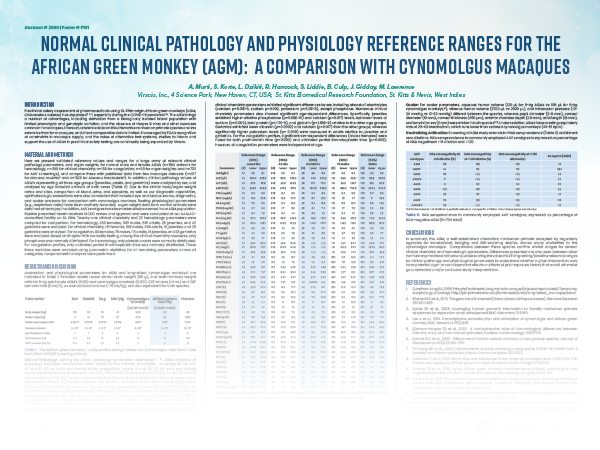Normal Clinical Pathology and Physiology Reference Ranges for the African Green Monkey (AGM)
A Comparison with
Cynomolgus Macaques

Unlock Insights in Clinical Pathology: AGM vs. Cynomolgus Macaques
Preclinical safety assessment of pharmaceuticals using African green monkeys (AGM) has witnessed a significant increase, presenting a valuable alternative to macaques. Our scientific poster presents validated reference values and ranges for various clinical pathology parameters in AGMs, offering a comparative analysis with cynomolgus macaques. With the growing recognition of AGMs in preclinical research, understanding their physiological characteristics becomes crucial for accurate interpretation of safety data.
Our scientific poster showcases validated reference values for a range of clinical pathology parameters, shedding light on species-specific differences and highlighting the importance of defining resting/baseline reference ranges. With insights gleaned from this comparative analysis, we empower researchers to detect potential age- and sex-specific effects of interventions that might otherwise go unnoticed.
Ready to Deepen Your Understanding? Download Our Scientific Poster Now!
Ready to Deepen Your Understanding? Download Our Scientific Poster Now!
Explore normal clinical pathology and physiology reference ranges for African green monkeys (AGM) compared to cynomolgus macaques.
At Virscio, we harness the power of comparative analysis to uncover essential insights in clinical pathology. By providing comprehensive data on normal physiology and pathology in AGMs, we enable researchers to make informed decisions in preclinical safety assessments and drug development.
In this scientific poster, you will learn more about:
- Comparative analysis of clinical pathology parameters between AGMs and cynomolgus macaques.
- Species-related differences in clinical chemistry and hematologic parameters.
- Identification of age- and sex-dependent variations in AGM physiology.
- Practical implications for preclinical safety assessments and drug development.
- References for further exploration and validation of findings.
